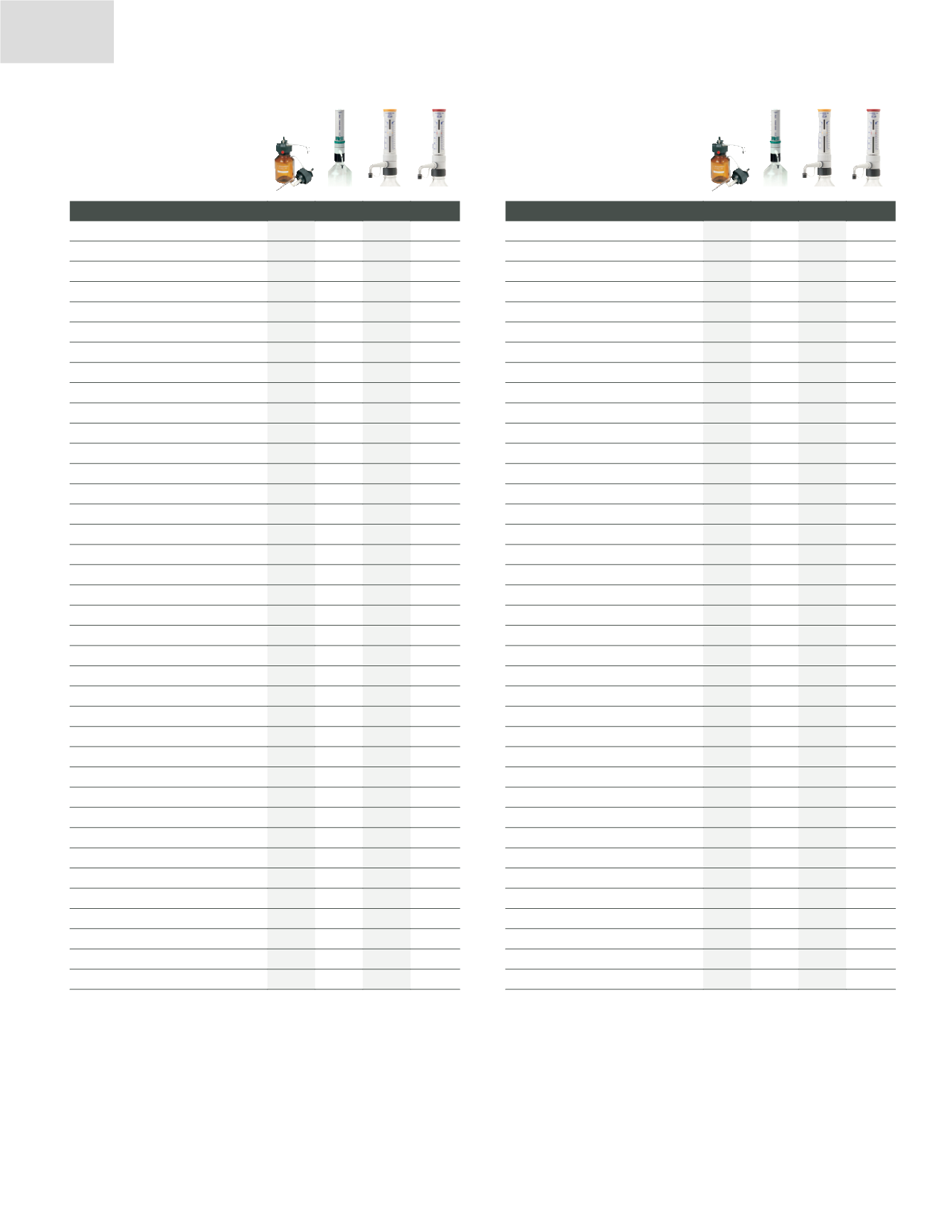

WHEATON
800.225.1437 (U.S. & Canada Only) | 856.825.1100 | 856.825.1368 (F) |
www.wheaton.comLiquid Handling
Dispenser Chemical Resistance
> 137
Reagents
501
520
525
530
Acetaldehyde (Ethanal)
A
A
Acetic acid 96%
A
B/2
Acetic acid 100% (glacial)
A
A
B/4
B/2/4
Acetic anhydride
B/4
B/4
B/4
B/4
Acetone (Propanone)
A
B/4
B/4
B/4
Acetonitrile (MECN)
A
A
B/4
B/4
Acetophenone
B/4
B/2/4
Acetyl Chloride
B/4
B/2/4
Acetylacetone
A
A
Acrylic acid
A
A
Acrylonitrile
B/4
B/4
Adipic acid
C/1
A
Allyl alcohol
A
A
Aluminum chloride
C/1
A
Amino acids
C/1
A
Ammonia 20%
B/4
B/4
Ammonia 20-30%
B/4
B/4
Ammonium chloride
C/1
A
Ammonium fluoride
C/1
A
Ammonium hydroxide
A
A
Ammonium molybdate
A
A
C/1
A
Ammonium sulfate
C/1
A
Amyl alcohol (Pentanol)
A
A
Amyl chloride (Chloropentane)
B/4
B/2/4
Aniline
A
A
A
A
Antimony trichloride
B/2
A
Ascorbic acid
A
A
C/1
A
n-Amyl acetate
B/4
B/4
Barium chloride
C/1
A
Benzaldehyde
A
A
A
A
Benzene
A
B/4
B/4
B/4
Benzine
A
A
Benzoyl chloride
B/4
B/4
Benzyl alcohol
A
A
Benzyl chloride
B/4
B/4
Bis(2-ethylhexyl) phthalate
A
B/4
B/4
B/4
Boric acid 10%
B/1
A
Boric acid
A
A
Reagents
501
520
525
530
Bromine
B/2
B/2
C/4
C/2/4
Bromobenzene
B/4
B/4
Bromonaphtalene
A
A
Butanediol
B/1
A
Butanol
A
A
A
A
Butanone (MEK)
A
B/4
B/4
B/4
Butyl acetate
A
A
B/4
B/4
Butyl acrylate
A
A
Butyl methyl ether
B/4
B/4
Butylamine
B/4
B/4
Butyric acid
B/4
B/4
Calcium carbonate
C/1
B/1
Calcium chloride
B/1
A
C/1
A
Calcium hydroxide
C/1
B/1
Calcium hypochlorite
C/1
B/1
Carbon disulfide
A
A
B/4
B/4
Carbon tetrachloride
A
A
B/4
B/4
Chlorine dioxide
B/4
B/2/4
Chlorine water
C/2/4
B/2/4
Chloro naphthalene
B/4
B/4
Chloroacetaldehyde 45%
B/1
A
Chloroacetic acid
B/1
A
Chloroacetone
B/4
B/4
Chlorobenzene
A
A
B/4
B/4
Chlorobutane
A
A
B/4
B/4
Chloroethanol
A
A
B/4
B/4
Chloroform
B/4
B/4
B/4
B/4
Nitro-hydrochloric acid (Aqua regia)
B/4
B/2/4
Chloronitric acid 100%
B/2/3
B/3
Chlorosulfuric acid
B/4
B/4
Chlorosulfuric acid 100%
B/2/3
B/3
B/3/4
B/3/4
Chromic acid 100%
B/2/3
B/3
B/3/4
B/3/4
Chromosulfuric acid 100%
A
A
C/1/3/4
B/2/3/4
Citric acid
B/1
A
Copper fluoride
A
A
C/1
B/1
Copper sulfate
C/1
A
Cresol
B/1
A
Cumene (Isopropylbenzene)
B/4
B/4
A = Good resistance
B = Acceptable with limitations
C = Not recommended
1 = Possible crystallisation - blockage or possible coating peeling (do not let dry plunger/barrel together).
2 = Swell of plunger protection layer, possible peeling.
3 = Acid vapours (better resistance with lower concentration). Do not leave instrument on bottle.
4 = Risk of damage, softening or discoloration of external parts through vapours. Do not leave instrument on bottle.
5 = Chemical degradation of glass parts (plunger/barrel).
Code explanations (525 / 530)
A = Good resistance
B = Acceptable with limitations
C = Not recommended
1 = Possible crystallisation - blockage (do not let dry plunger/barrel together).
2 = Swell of plunger protection layer, possible peeling.
3 = Acid vapours (better resistance with lower concentration). Do not leave instrument on bottle.
4 = Risk of softening or discoloration of external parts through vapours. Do not leave instrument on bottle.
5 = Chemical degradation of glass parts (plunger/barrel).
Code explanations (501 / 520)
















